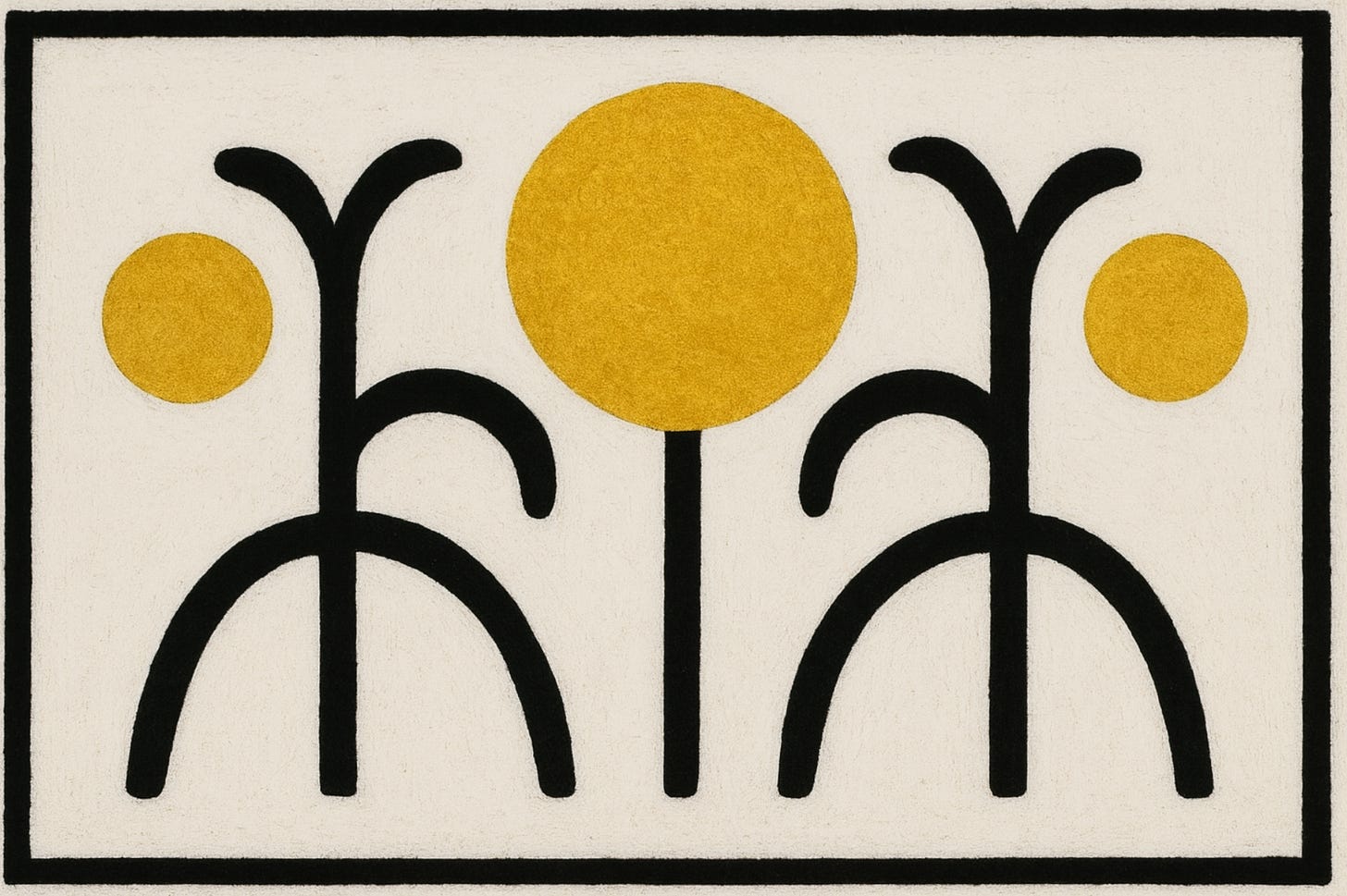Towards a Theory of Side-Eye
Yara Flores in Conversation with D. Graham Burnett
Longtime friend of The Hinternet D. Graham Burnett is back again to share with us this rare conversation, held in December, 2024, with the reclusive artist Yara Flores. (Our own JSR once almost met Yara, at the “Curiosity and Method” conference at Princeton University in 2012 — both were in attendance, yet somehow their paths never quite crossed.) Graham and Yara are, plainly, two kindred spirits. Both care deeply, in particular, about the dangers posed to the human faculty of attention, and therefore to the human spirit, by our new and unbelievably rapacious tech-driven economy of “attention fracking”. Graham is so concerned, in fact, that he has recently co-written a book, Attensity! (a word with some real history to it, incidentally) described by Chris Hayes as “a stirring battle cry on behalf of our shared humanity against the forces that seek to diminish and degrade it. Downright invigorating. Just what the moment calls for.” Both Graham and Yara are likewise convinced that the story of how we landed in this crisis has much to do with the history of science, and, moreover, that the best hope for finding a way out has much to do with the creative arts. Let’s find out what they have to say to one another.
But before we do, won’t you please consider upgrading to a paid subscription? For some time now these have been on a worrisome churn-driven downward slope. We keep getting more readers, and more love — but less earthly reward for it! We generally suppose that nothing but more work can turn that around, but have also considered trying a straight plea, such as this one, to see whether that is not more effective. So if you enjoy our work, please remember that the ongoing creation of it is entirely dependent on your paid subscriptions. Thank you. —The Editors
DGB: Yara, it is good to be back in touch. We’ve crossed paths over the years, and I think when I last checked in, you were working on your “Portable Monstrance” series — a set of images documenting photographic reflectors pierced and positioned to vignette or “halo” different objects in the world. I first came across this work in the CAC Bukovje volume Eleven Years (2022). The idea, as I understand it, was to highlight a certain kind of “sacral centrality” in our relationship to what obtains — or, perhaps more ironically, to play on the transfiguring power of modern optical technologies. This project was certainly “about” ATTENTION, in some sense.
YF: Yes, to be sure. The “Monstrance” is, if you like, a pre-modern technology of “attention capture” — a gilt frame that points, dramatically and centripetally, to what it “contains.” I was drawn to the way that the round , silver- and gold-tone “bounce cards” used by professional photographers had their own kind of “bank-shot” radiance, and performed a hidden and heightening solarization. Of course, what the original ecclesiastical monstrance was meant to hold (to show, as the etymology of its name suggests, from the Latin monstrare, meaning “to show or demonstrate”) was the consecrated “Eucharist” — which, within the mythology of Christendom, was an actual bit of God. By placing various other things (twigs, sidewalk spittle, etc.) at the center of my mock-up monstrances, I was interested in invoking the rich traditions of Spinozist pantheism — that notion that “God” is everywhere and everything. It is also the case that there is an unsettling concept-rhyme in there — in that one inevitably hears the word “monster” in “monstrance.” Now “monster” actually comes from a slightly different root (monere, Latin for “to warn”), but “warning” and “showing” are certainly entangled. And there is very definitely something “monstrous” about every effort to “center” on this or that. Every effort to seize and hold our attention. One wants to be warned!
DGB: Ah, that’s interesting. I had not caught that in there. But I see what you are getting at. Other projects of yours also take up the problem of attention, I think. There was your exhibition on “Greebles,” which were really materialized stimuli in experimental psychology. Or, in a different way, your film, “The Kinetics of Textual Immersion (Part III: Involuntary and Repetitive Motions),” which I saw back in 2016 at a screening in Eva Hesse’s old studio on the Bowery. That long, single shot centers on a bare human toe — and simply lingers on this toe as it twitches slightly. The implication is that the human attached to that foot is reading, and that this immersive attention is being, perhaps, indexed by the strange little squirmings of that appendage.
YF: Yes. What does Bataille say? “The big toe is the most human part of the human body.” My film is really best understood as a gloss on that famous opening sentence of « Le gros orteil” » (1929). I wanted to investigate the embodied character of certain paradigmatically cognitive states — like “deep focus” or whatever. I have always been interested in the peripheral, and particularly in the paradoxical or suspended connection between centers and margins. That whole series of shorts came out of a set of “reading residencies,” so I was thinking a lot about the phenomenology of textual experience. Stills from that particular film were subsequently published in Reading Room (2020), with a set of annotations that addressed the issue of the rhythmic synchrony of joint attention — to books in particular.
DGB: Can you say more about what you mean by the “paradoxical connection between centers and margins?”
YF: Sure. I am very much thinking about that powerful and strange phenomenon known as “averted vision” — that uncanny feature of the human eye that causes us to be able to see things at the edge of our field of sight that we literally cannot see if scrutinized directly. I’m aware that you have yourself written about this, since your brief treatment of the subject in the introduction to Curiosity and Method (2012), was an early inspiration for me. As youare aware, this effect was known in antiquity, and early astronomers used it to help them spot faint stars, even though they did not understand its physiological basis. We now know that the retina of the human eye is made up of two different kinds of receptor cells, rods and cones. The rods are much more sensitive, and can be triggered by just a few photons. The cones need a lot more luminosity to get a signal, but they are capable of providing information about color. Humans evolved to have a much higher density of cones in the middle of the retina, in what is called the “fovea.” This means we have a lot of visual richness to the center of our visual field — but our low-light acuity in that region is poor. If you want to see a very very small star, you have to center your vision on something else in the sky, and then gradually “become aware” of that star at the edge of your vision. If you then look to it, that faint star literally disappears. It is one of the oddest phenomena in our optical existence! And I think it discloses a great deal — both as a metaphor and as something more than a metaphor.
DGB: I agree! It is indeed uncanny!
YF: It discloses that our access to the most subtle things is always a matter of looking askance. And it establishes the importance of indirection as a FORM OF ACCESS — an antinomy that speaks volumes. There is, I think, an actual theory of the art object in there. I won’t spell it out, since that would be rather to miss the point, eh?
DGB: I follow you, but out of the corner of my eye, if you will! From my perspective, what is so powerful about averted vision is the role it plays in the emergence of scientific conceptualization of “attention” itself. That angular separation — between the object at the center of your field of vision, the one you are “looking at,” and the thing at the periphery that you are “trying to see” — marks the distinction between attention as a “physiological” thing (your eyes are where your attention “is”) and a cognitive thing. It is, after all, some kind of mental “attention” that is over there examining the periphery, NOT your eyes.
YF: It is a deep point. And this ties back to the original experiments by Helmholtz and others, in the mid-nineteenth century. They were studying the physiology of vision. But “attention” swam into view as something else, precisely as they began to wonder about where “consciousness” was directed within the visual field — or within other sensory fields, like sound or touch. What was the “presence of consciousness” within the broader domain of sensation? It was the locus of attention. In one sense, this is a metaphysical mystification. But in another sense, it becomes possible to dig in on grasping that “presence of consciousness” empirically — and the “science of attention” is born.
DGB: Exactly. As you know, I think, this was the thematic focus of the studio I ran at the Academy of Fine Arts in Helsinki last year, where I presented “The Tip of the Finger and the Moon: Three Meditations on Averted Attention.”
YF: Right. But can I press on all that for a moment? What is the relationship, in your view, between that history of science story around attention and the questions at stake in ART? The questions at stake in art making?
DGB: Oh, that is a very large question. And a hard one. You seem, suddenly, to be going right at the thing! But we have already agreed that important things will elude us if we adopt that posture!
YF: And yet, sometimes nothing else will do. We have to focus!
DGB: I’m tempted to deflect you with your own work. I am thinking of your 2018 piece, “Love Letter for Émile Javal (#5),” which I saw at the Mana Contemporary show Please Touch: Body Boundaries. In that installation you reference a silly moment in an old James Bond film — I think it is Goldfinger (1964) — in which Sean Connery sees his attacker approaching him from behind reflected in the eye of the girl he is kissing. Is that about focus? Or about “peripheral vision”?
YF: Ha. OK, that’s cute. That piece is again about obliquity, for sure, and about what we might call ricochet-vision. A kind of preposterous vigilance — where we remember what that term actually means: “pre” (before) and “posterior” (the hinderparts); hence, pre-posterous, meaning “with the back facing front,” or even “ass-backwards.”
DGB: Fair enough! There is enough irony to go around. In that Javal, of course, is the French experimental physiologist who discovered the “saccade” — or the rapid eye-skitter of reading…
YF: …and tragically WENT BLIND later in life. Writing so movingly about the experience of losing his sight, as a scientist of visual experience…
DGB: Indeed. But I guess there is another way that “Love Letter” feels relevant: the piece very much reminds us that there are adversaries out there!
YF: True enough. Coming up behind us!
DGB: And there are! And that takes us back to your direct question — about the relationship between our revolutionary/watershed ATTENTION moment, and art making. Because there is an adversary, and that is the central issue — the real issue, the central issue at which we have to keep STARING, if any of the subtle stuff is going to be seeable at the margins. It goes like this: the actual enemy of humanity, non-human being, and the planet itself, at this point, is the ongoing scorched-earth victory of money-value over all other forms of value. The precise history of this progressive defeat of other languages and discourses of value is interesting, but a story for another time. An account of how and why it has happened — is happening — let’s bracket that for now. But if we agree that it is indeed happening…
YF: And we do!
DGB …then it is all hands on deck! Because we absolutely MUST hold space for alternatives. We absolutely MUST push back against this dehumanizing process and its catastrophic consequences.
YF: And you feel that “attention” is a key part of that fight?
DGB: I do. And so do a lot of other people. This is hardly “my” idea. Already we have nearly a generation of folks pushing a version of this argument.
YF: You mean “attention activism,” basically?
DGB: For sure. Lots of names there. Let’s jump past that for now. The key issue is that the “commodification” of “attention” represents the latest frontier in capital’s instrumentalizing incursions into non-inhuman being. Call it the dialectical “last stand.”
YF: And the arts play a role here?
DGB: They do. A key role — and more than a “role”…
YF: I think this is at the center of my own practice, really. I’ll lay out my own view: What “art” is, is precisely an attentional ecosystem: the work of art can be best understood as a reified attentional solicitation, which proceeds from (and carries into the world) an attentional process or dynamic — and, in turn, it sets such a dynamic in motion. Artworks aren’t “memes” in the tragic quantifying logic of the marketplace. They are more like attentional “hyperstitions” — attentional propositions that have the power to make themselves real in the world. When they work, they are self-activating attentional situations. Or artifacts that vibrate on the boundary between thing and process…
DGB: …which is arguably what human attention is, a vibration on the boundary between things and processes!
YF: Although, as I understand it, you tend to be resistant to “definitions” of attention, preferring a kind of “apophatic” approach to the problem…
DGB: Quite right. You have probably heard me invoke that lovely passage from Henry James, concerning the “empty cup” of attention, crystalline and clear. That image, from Wings of the Dove (1902), perfectly holds space for the openness and imminence of the attentional situation.
YF: And yet it is so perfectly at odds with the logic of our current attentional ideology.
DGB: Which proceeds from a very particular line of experimental work in the human sciences, much of it conducted under the Cold War conditions of the military-industrial complex, which was interested in the cybernetic integration of humans and machines, and studied “attention,” experimentally and rigorously, as the set of tracking and triggering problems at stake in a robust and reliable instrumentalization of human sensory and cognitive capacities . These were needed to “invigilate” the SYSTEMS. The paradigm was strictly behaviorist. The issue was stimulus and response in an informational array.
YF: Which turns out to be a quantifiable index of consciousness that is perfectly pre-stressed for commodification.
DGB: Bingo.
YF: “Human fracking,” as you call it.
DGB: It is as close as anyone has yet gotten to the monetization of the human spirit itself.
YF: Dark.
DGB: For sure. But it is VERY IMPORTANT NOT TO GET DOWNHEARTED! Non-inhuman being is going to prevail. We are on the cusp of a revolutionary transformation. Classic dialectic: attention is becoming politicalin a radical new way; and, as ever, the arts are integral to that novel form of cultural coming-to-awareness.
YF: I think I have a sense of how you make this argument. And I feel I see aspects of my own practice in your account. It is as if the core analysis of the neuroscience of attention — that there are “top down” and “bottom up” attentional modes — needs to be actively détourné. We need it to move our attention “sideways” to escape that imprisoning 1950s communication-theory logic. Art is powerful in this regard.
DGB: Yes, exactly.
YF: I like the Jamesian “crystal cup” theory of attention, but I really feel it needs a sprucing up in gender-theoretical terms. The openness here puts me in mind of Ursula Le Guin, and her much-beloved “carrier bag theory of fiction” — where it is narrative itself that can “hold” human and non-human diversity, precisely to the extent that stories decline to operate “teleologically,” with the narrow logic of arrow-to-target. For her, this is the holding-and-carrying logic of bodies and lives and forms of care that are canonically gendered female.
DGB: It is a beautiful insight. The oblique and the sidelong, PLUS the openness and the holding/bearing. Yes: I see it! The “carrier bag theory of attention”!
YF: Now there is a theory of the art object!
DGB: Yara, I am moved by that. Shall we leave it there?
YF: I think we could.
DGB: Thank you for the time. And… your attention.







This is great, and I’ll be adding “art as attentional ecosystem” to my list of answers to “what is art?”
The idea of sideways attention is a striking one, and reminds me of one of my favorite lines from the Upaniṣads: "the gods, it seems, love what is hidden and hate what is obvious".